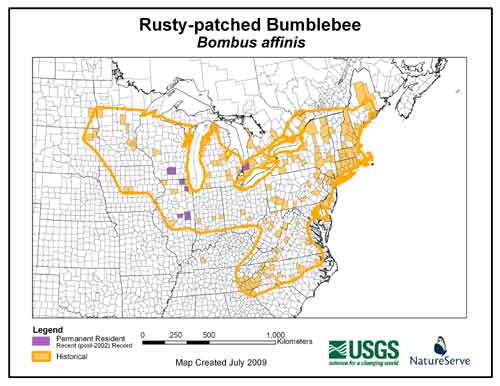Habitat and Geography
The rusty-patched bumble bee typically builds annual colonies in underground nests in preexisting holes, or at ground level in grass tussocks. They will often protect their cocoons and food cells with a wax roof in the nest which is supported by various other nesting materials. At the end of a season the colony dies and only young fertilized queens hibernate after burrowing in the soil. They do not seem to associate with specific environments, but reproduce in environments with high flower diversity and continuous blooming from April to July.
 The
rusty-patched bumble bee is mostly found in cool or temperate regions. It
ranges across Quebec to the Dakotas and south to Georgia. The former range
of the bumble bee included these states: Minnesota, Wisconsin, Indiana,
lower Michigan, Ohio, Pennsylvania, New York, Vermont, New Hampshire, Maine,
Maryland, Virginia, North Carolina, South Carolina, Georgia, and portions of
North Dakota, Iowa, Illinois, Kentucky, and Tennessee. However, this has
steeply declined and a recent survey showed that it has not been found it
this range except for a few isolated areas in Illinois and a single site in
Wisconsin. This decline is believed to be due to a pathogen, possibly
Nosema bombi.
The
rusty-patched bumble bee is mostly found in cool or temperate regions. It
ranges across Quebec to the Dakotas and south to Georgia. The former range
of the bumble bee included these states: Minnesota, Wisconsin, Indiana,
lower Michigan, Ohio, Pennsylvania, New York, Vermont, New Hampshire, Maine,
Maryland, Virginia, North Carolina, South Carolina, Georgia, and portions of
North Dakota, Iowa, Illinois, Kentucky, and Tennessee. However, this has
steeply declined and a recent survey showed that it has not been found it
this range except for a few isolated areas in Illinois and a single site in
Wisconsin. This decline is believed to be due to a pathogen, possibly
Nosema bombi.
Ecological Niche
Bumble bees are important pollinators of wild flowering
plants and crops. They are generalist foragers, and do not depend on a
specific flower type for pollen. However, some plants do rely on bumble bees
to achieve pollination. Bumble bees are considered to be subsocial. This is
because the bumble bee colony does not have true social existence because
they are not social year round. Bumble bees gather only a small quantity of
honey. In the winter, only the young queen hibernates through the winter
unprotected and vulnerable to attack by many predators.
Check out Adaptations of the rusty-patched
bumble bee!